Abstract
The dna-1, dna-2, dna-7, and dna-28 mutations, all of which are located near min 89.5 on the E. coli linkage map, have been characterized further. As previously demonstrated for dna-2 and dna-28, neither the dna-1 nor dna-7 mutation affects the ability of a strain to produce bacteriophage lambda at temperatures non-permissive for the continued replication of the bacterial chromosome. The reported temperature-sensitive inhibition of lambda production in a strain carrying dna-7 is shown to be a consequence of a thermosensitive host specificity mutation in the hsm gene and not of the dna-7 mutation. The four dna mutations are recessive to the wild type and define a single dnaC cistron according to standard complementation criteria. Unlike other characterized dnaC mutants, however, strains carrying the dnaC1 or dnaC7 alleles exhibit an abrupt cessation of deoxyribonucleic acid synthesis at 42 C that appears to be more compatible with a defect in deoxyribonucleic acid chain elongation rather than in initiation. The possibility that the apparent elongation defect is actually a composite effect of residual synthesis and deoxyribonucleic acid degradation is raised by the net deoxyribonucleic acid degradation observed in the dnaC1 strain at 42 C. Several alternative possibilities for the function of the dnaC gene product are suggested.
Full text
PDF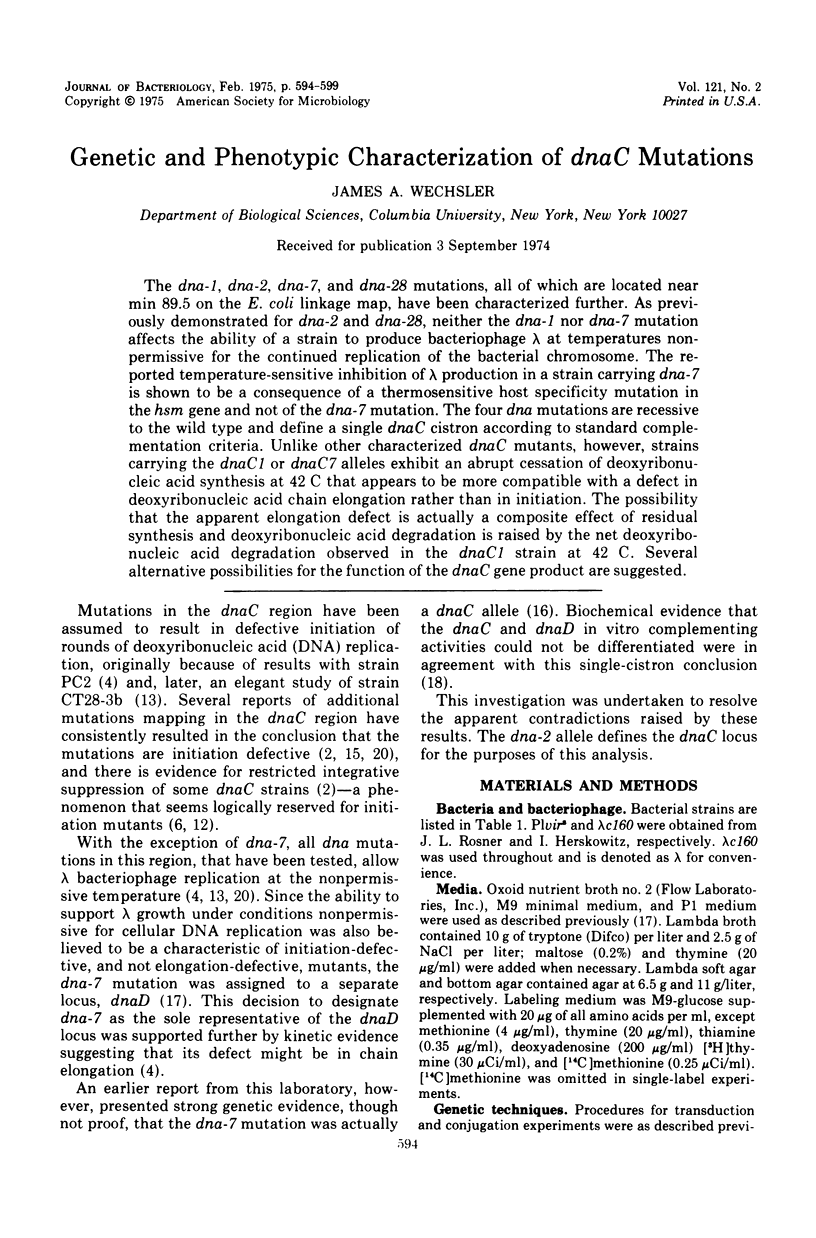
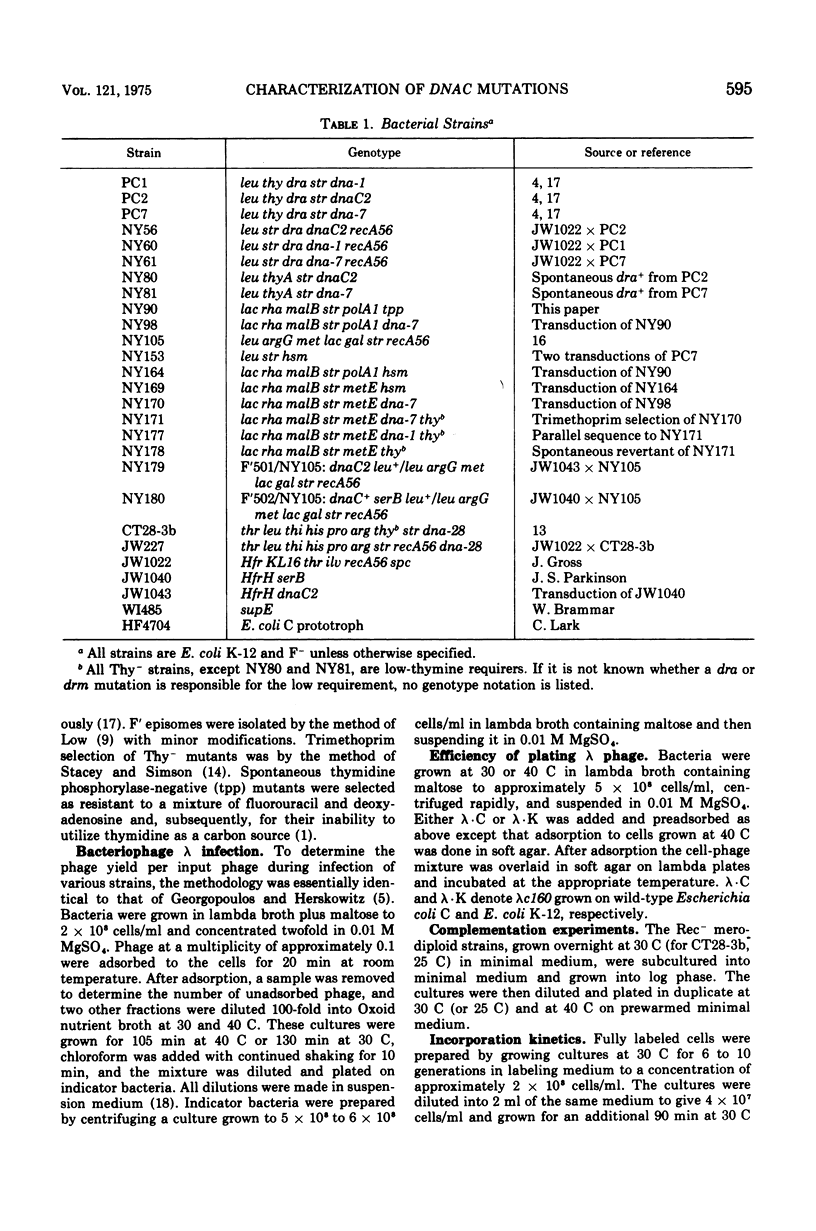

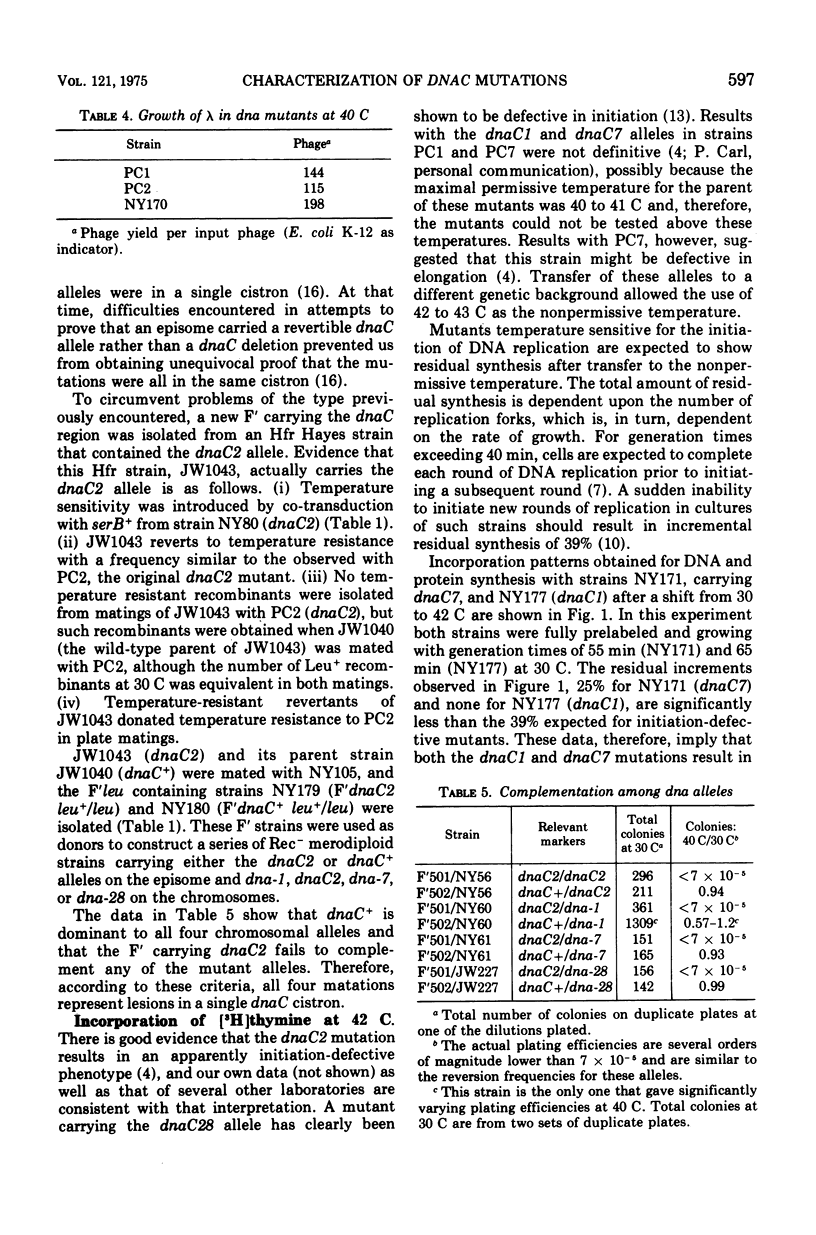
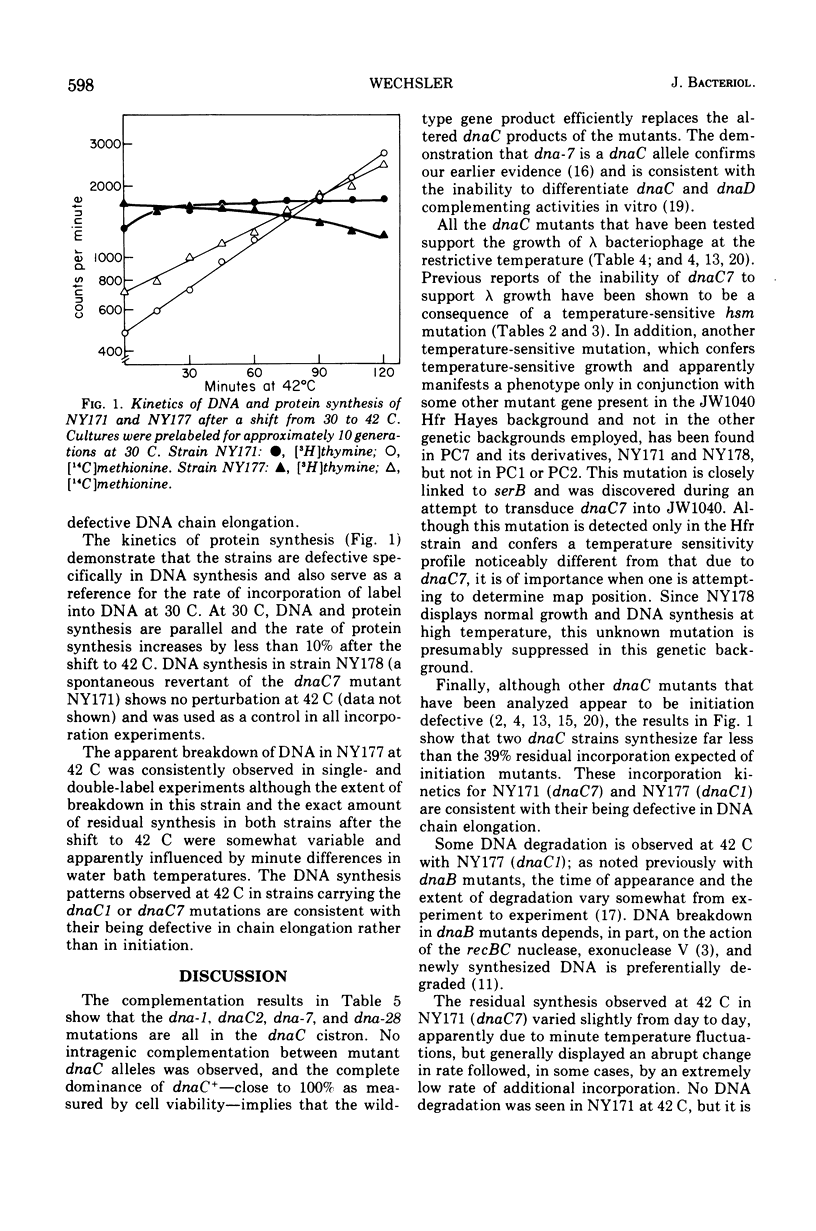
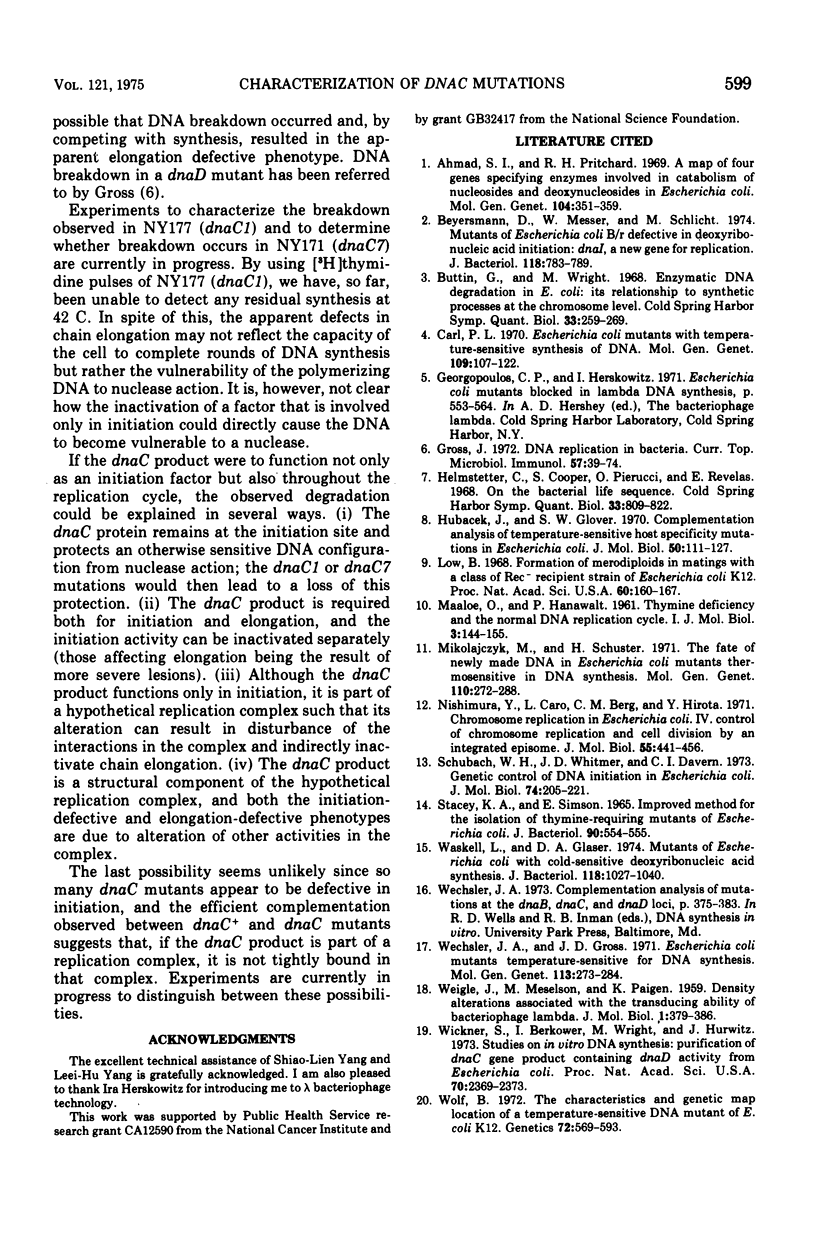
Selected References
These references are in PubMed. This may not be the complete list of references from this article.
- Ahmad S. I., Pritchard R. H. A map of four genes specifying enzymes involved in catabolism of nucleosides and deoxynucleosides in Escherichia coli. Mol Gen Genet. 1969 Aug 15;104(4):351–359. doi: 10.1007/BF00334234. [DOI] [PubMed] [Google Scholar]
- Beyersmann D., Messer W., Schlicht M. Mutants of Escherichia coli B-r defective in deoxyribonucleic acid initiation: dnaI, a new gene for replication. J Bacteriol. 1974 Jun;118(3):783–789. doi: 10.1128/jb.118.3.783-789.1974. [DOI] [PMC free article] [PubMed] [Google Scholar]
- Buttin G., Wright M. Enzymatic DNA degradation in E. coli: its relationship to synthetic processes at the chromosome level. Cold Spring Harb Symp Quant Biol. 1968;33:259–269. doi: 10.1101/sqb.1968.033.01.030. [DOI] [PubMed] [Google Scholar]
- Carl P. L. Escherichia coli mutants with temperature-sensitive synthesis of DNA. Mol Gen Genet. 1970;109(2):107–122. doi: 10.1007/BF00269647. [DOI] [PubMed] [Google Scholar]
- Gross J. D. DNA replication in bacteria. Curr Top Microbiol Immunol. 1972;57:39–74. doi: 10.1007/978-3-642-65297-4_2. [DOI] [PubMed] [Google Scholar]
- Helmstetter C., Cooper S., Pierucci O., Revelas E. On the bacterial life sequence. Cold Spring Harb Symp Quant Biol. 1968;33:809–822. doi: 10.1101/sqb.1968.033.01.093. [DOI] [PubMed] [Google Scholar]
- Hubacek J., Glover S. W. Complementation analysis of temperature-sensitive host specificity mutations in Escherichia coli. J Mol Biol. 1970 May 28;50(1):111–127. doi: 10.1016/0022-2836(70)90108-7. [DOI] [PubMed] [Google Scholar]
- Low B. Formation of merodiploids in matings with a class of Rec- recipient strains of Escherichia coli K12. Proc Natl Acad Sci U S A. 1968 May;60(1):160–167. doi: 10.1073/pnas.60.1.160. [DOI] [PMC free article] [PubMed] [Google Scholar]
- MAALOE O., HANAWALT P. C. Thymine deficiency and the normal DNA replication cycle. I. J Mol Biol. 1961 Apr;3:144–155. doi: 10.1016/s0022-2836(61)80041-7. [DOI] [PubMed] [Google Scholar]
- Mikolajczyk M., Schuster H. The fate of newly made DNA in Escherichia coli mutants thermosensitive in DNA synthesis. Mol Gen Genet. 1971;110(3):272–288. doi: 10.1007/BF00337839. [DOI] [PubMed] [Google Scholar]
- Nishimura Y., Caro L., Berg C. M., Hirota Y. Chromosome replication in Escherichia coli. IV. Control of chromosome replication and cell division by an integrated episome. J Mol Biol. 1971 Feb 14;55(3):441–456. doi: 10.1016/0022-2836(71)90328-7. [DOI] [PubMed] [Google Scholar]
- STACEY K. A., SIMSON E. IMPROVED METHOD FOR THE ISOLATION OF THYMINE-REQUIRING MUTANTS OF ESCHERICHIA COLI. J Bacteriol. 1965 Aug;90:554–555. doi: 10.1128/jb.90.2.554-555.1965. [DOI] [PMC free article] [PubMed] [Google Scholar]
- Schubach W. H., Whitmer J. D., Davern C. I. Genetic control of DNA initiation in Escherichia coli. J Mol Biol. 1973 Feb 25;74(2):205–221. doi: 10.1016/0022-2836(73)90107-1. [DOI] [PubMed] [Google Scholar]
- Waskell L., Glaser D. A. Mutants of Escherichia coli with cold-sensitive deoxyribonucleic acid synthesis. J Bacteriol. 1974 Jun;118(3):1027–1040. doi: 10.1128/jb.118.3.1027-1040.1974. [DOI] [PMC free article] [PubMed] [Google Scholar]
- Wechsler J. A., Gross J. D. Escherichia coli mutants temperature-sensitive for DNA synthesis. Mol Gen Genet. 1971;113(3):273–284. doi: 10.1007/BF00339547. [DOI] [PubMed] [Google Scholar]
- Wickner S., Berkower I., Wright M., Hurwitz J. Studies on in vitro DNA synthesis: purification of dna C gene product containing dna D activity from Escherichia coli. Proc Natl Acad Sci U S A. 1973 Aug;70(8):2369–2373. doi: 10.1073/pnas.70.8.2369. [DOI] [PMC free article] [PubMed] [Google Scholar]
- Wolf B. The characteristics and genetic map location of a temperature sensitive DNA mutant of E. coli K12. Genetics. 1972 Dec;72(4):569–593. doi: 10.1093/genetics/72.4.569. [DOI] [PMC free article] [PubMed] [Google Scholar]


